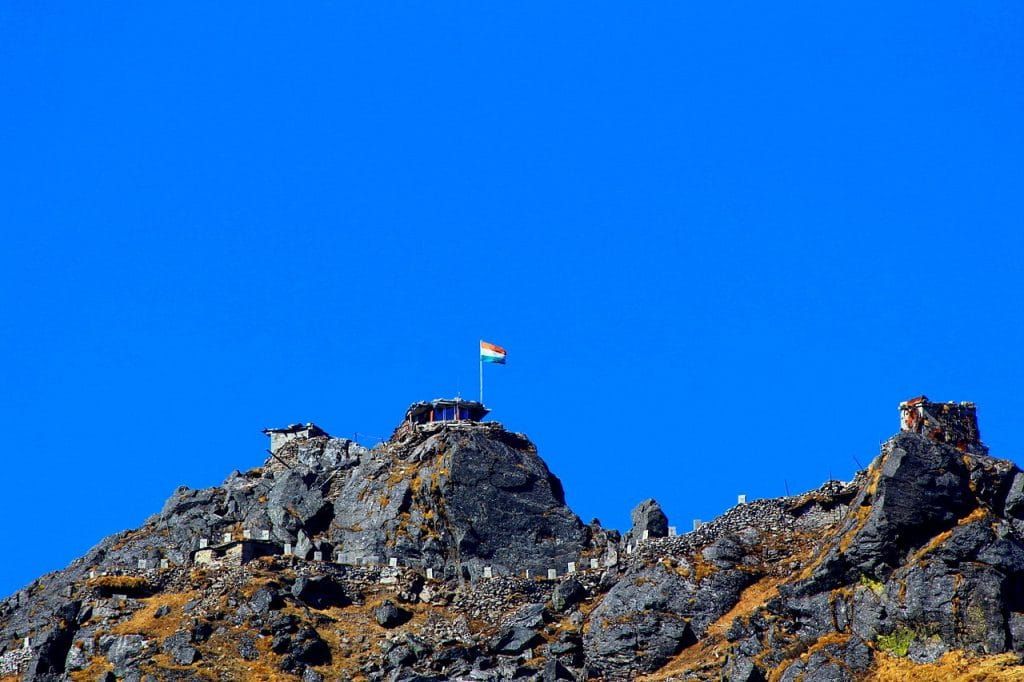Sticks, stones, and words: “Ugly stability” between India and China
By Karthika Sasikumar | July 13, 2020
 An Indian border outpost at Nathu La, in Sikkim. Though many of the border skirmishes between Indian and Chinese troops took place in Ladakh, some happened in Sikkim as well. Photo credit: Vinay.vaars via Wikimedia Commons.
An Indian border outpost at Nathu La, in Sikkim. Though many of the border skirmishes between Indian and Chinese troops took place in Ladakh, some happened in Sikkim as well. Photo credit: Vinay.vaars via Wikimedia Commons.
Albert Einstein famously quipped that World War IV would be fought with sticks and stones. He reasoned that any World War III would involve the use of nuclear weapons, after which human society would return to an era of primitive technology. But some countries, it seems, are already living this prediction. The recent border clashes between India and China show that conflict under the nuclear shadow can feature both brutish hand-to-hand combat and verbal signaling. The encounter is also a vivid demonstration of the ugliness of the so-called “stability” that nuclear weapons have brought to Southern Asia.
The context. India and China have disagreed on the delineation of their mutual boundaries ever since their creation. In 1962, India adopted a “forward policy” on the border, which involved aggressive patrols and the establishment of military outposts in areas claimed by China, but this was met with fierce Chinese resistance. The result was a month-long war in which China captured territory, and then withdrew to positions that became known as the “line of actual control.” The line of actual control has been the de facto border between the two countries ever since.
Sino-Indian relations improved by the start of the 1990s. In 1993, the two sides made an agreement that placed the border issue on the back burner. Today, China and India are aligned on certain global issues—climate change, Islamist terrorism, and even wariness about the US presence in Asia. China is also India’s largest trading partner, though the economic relationship is heavily imbalanced; China’s exports to India stood at $74 billion in 2019, while India’s exports to China totaled only $17.8 billion.
But there have been tensions too. India’s formal declaration of nuclear weapon state status in May 1998, and its slow but steady nuclear buildup since, were justified to the world as a response to a rising China.
Since 2017, there have been several border incidents that have heightened Indian decision makers’ concerns about limited military operations and the loss of Indian territory. In the worst-case scenario, Indian officials feared, China could take over some Indian-held territory in conventional border skirmishes, and then leverage its larger nuclear arsenal to prevent Indian troops from retaking it.
The spike in tensions. The first half of 2020 has been nightmarish for China’s leaders. The spread of coronavirus from Wuhan, its impact on the economy and China’s reputation overseas, as well as unrest in Hong Kong and greater assertiveness from Taiwan, made Chinese officials nervous about any type of threat. China’s Navy has been conducting aggressive operations in the South China Sea, while its legislature recently passed a law suppressing opposition in Hong Kong.
India has had its own traumas, not least due to the coronavirus, which is estimated to have infected half a million people by late June. A slowdown in economic growth, which began in 2018, has been worsened by the pandemic. Beijing and New Delhi went into the summer on edge, distrustful of each other, and no longer heedful of an increasingly preoccupied United States.
As India proceeded with the construction of border roads, which would allow New Delhi to speedily transport troops, China began to apply pressure on the ground, where the snows had begun to melt. Recent decisions by the Indian government on its troubled Kashmir province also affected the region of Ladakh, which borders the line of actual control. India’s Parliament abrogated a controversial article of the constitution, ending the autonomous political status of Jammu and Kashmir, and constituting Ladakh as a Union Territory to be administered directly by the central government. China was upset about Ladakh’s status, as it seemed to reiterate Indian claims to disputed territory. This spring saw reports of multiple skirmishes between soldiers stationed in these inhospitable border posts.
The most serious clash took place in the Galwan Valley in eastern Ladakh, a normally quiet part of the border. On the night of June 15, a brawl broke out between Indian and Chinese military personnel in almost the same spot where the countries had fought their war in 1962, leaving 20 Indians and an unconfirmed number of Chinese dead. The belligerents reportedly used clubs studded with nails, stones, iron rods, and even fists, but not firearms. Per a 1996 bilateral agreement, troops deployed in this sensitive border area are prohibited from carrying guns or explosives. Both sides apparently recognized the danger of escalation to the nuclear level and had sought to prevent it by removing weapons from the lowest level of interaction.
The fallout. The horrific images of soldiers beaten to death with these primitive weapons infuriated the Indian public. Notwithstanding public anger, New Delhi’s response to the Galwan Valley incident was described in a New York Times op-ed as “mild, almost careful not to offend China.” At an all-party conference, Prime Minister Modi denied that there had been an incursion and insisted that no Indian territory had been compromised. It was clear that Modi’s government had chosen to de-escalate and put the ball into Beijing’s court. In the weeks that followed, talks were held at senior military levels to work out the details of mutual withdrawal.
The Indian government’s choice of de-escalation was disappointing to Indian military hawks, and to its ever-growing array of high-pitched media figures and security experts. On Twitter, there were calls for “Churchillian defiance,” encouraging India to carry on the fight, perhaps in concert with the United States, Australia, and Japan. For some, the government had “underplayed” the situation.
New Delhi’s decision is a capitulation to a realist calculation that China outstrips India in both conventional and nuclear strength. Modi’s advisors may also be realizing the limits and the immense potential for blowback from using the media to rouse nationalist passions—as the opposition mocked them, and their past tweets calling for assertive action against Pakistan and China went viral. They may be relying on the power of words to extract themselves from the unintended, yet perilous, consequences of blunders and misunderstandings by weary troops in inhospitable conditions.
In September 2016, after a terrorist attack on an Indian Army camp in Kashmir, the Modi government carried out a so-called “surgical strike” against Pakistan. It would later reap electoral rewards from this operation. Even this overt demonstration of Indian resolve and military prowess was carefully calibrated, though. Statements from New Delhi framed the strikes as a response to provocation, highly precise, and limited in scope. Similar rhetorical moves can be seen in Modi’s recent statement, as well as in official denials that Indian personnel were missing in action.
Verbal signaling seems to be working in 2020 as well. Chinese leaders were eager to de-escalate for two reasons. First, although a barefaced defeat on the Himalayan border would have been a devastating loss of face, India overall is not a salient threat for the average Chinese person on the street. Second, given the other foreign and domestic issues it was engaged in, the Chinese leadership wanted to avoid being forced into escalation by inflamed public opinion. Accordingly, state-controlled media were ordered to downplay the clashes, and no information was released on Chinese military casualties.
But the war of words continues in the economic sphere. Techno-nationalism is on the rise in India, as evidenced by Modi’s Make in India and post-COVID aatmanirbharta (self-reliance) campaigns. There is also a social media campaign urging Indians to boycott Chinese goods and technology services, along with reports that the government will ban the Chinese telecom giant Huawei from operating in India.
The outlook. In the late 1990s, strategist and national security expert Ashley Tellis coined the term “ugly stability” to describe the India–Pakistan strategic relationship in the shadow of nuclear weapons. As full-scale war becomes increasingly unlikely, there are incentives for the countries (and non-state actors) to mount low-level operations, such as incursions or assaults on military installations. It appears that the ugliness has begun to surface in the India–China relationship as well.
Neither China nor India wants a full-fledged war, but leaders in both countries are aware of the space for combat that remains open well below the strategic level. On the one hand, this awareness pushes them to take precautions against escalation—for instance, by limiting the armaments available to troops stationed on the border. On the other hand, neither country is above exploiting this so-called “sub-strategic space” to give the other a bloody nose, if it would help with domestic approval ratings.
In short, these two nuclear-armed powers are likely to use both sticks and stones as well as words as weapons in their future encounters.
Together, we make the world safer.
The Bulletin elevates expert voices above the noise. But as an independent nonprofit organization, our operations depend on the support of readers like you. Help us continue to deliver quality journalism that holds leaders accountable. Your support of our work at any level is important. In return, we promise our coverage will be understandable, influential, vigilant, solution-oriented, and fair-minded. Together we can make a difference.
Keywords: China, India, South Asia, border dispute, escalation, stability-instability paradox
Topics: Nuclear Risk















